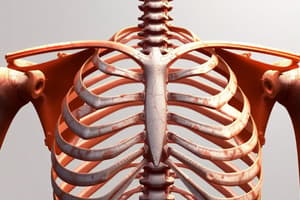Podcast
Questions and Answers
Which bone is found in the upper arm region?
Which bone is found in the upper arm region?
- Humerus (correct)
- Scapula
- Ulna
- Radius
Which part of the humerus articulates with the glenoid cavity of the scapula?
Which part of the humerus articulates with the glenoid cavity of the scapula?
- Distal humerus
- Greater tubercle
- Anatomical neck (correct)
- Intertubercular groove
What is the bony area on the lateral side of the proximal humerus called?
What is the bony area on the lateral side of the proximal humerus called?
- Anatomical neck
- Greater tubercle (correct)
- Intertubercular groove
- Lesser tubercle
Which bone provides leverage for the muscles of the arm?
Which bone provides leverage for the muscles of the arm?
What passes between the greater and lesser tubercles of the humerus?
What passes between the greater and lesser tubercles of the humerus?
Which region of the upper limb is distal to the wrist?
Which region of the upper limb is distal to the wrist?
Where is the surgical neck located in the humerus?
Where is the surgical neck located in the humerus?
Which part of the humerus forms a lateral supracondylar ridge?
Which part of the humerus forms a lateral supracondylar ridge?
What are the articulating surfaces of the distal humerus?
What are the articulating surfaces of the distal humerus?
What joints form the elbow joint?
What joints form the elbow joint?
How many bones make up the carpal region?
How many bones make up the carpal region?
How many phalanges does each finger have?
How many phalanges does each finger have?
Flashcards are hidden until you start studying
Study Notes
Bones of the Upper Limb
The upper limb is a complex and versatile structure, composed of 30 bones, which are essential for our ability to perform daily tasks and engage in activities that require dexterity and complex movements. These bones are divided into three regions: the arm, which extends from the shoulder to the elbow; the forearm, between the elbow and wrist; and the hand, distal to the wrist.
Arm (Humerus)
The upper arm region is composed of a single bone, the humerus, which is a long, heavy bone that provides leverage for the muscles of the arm. The humerus can be divided into two parts: the proximal and distal humerus.
The proximal humerus is characterized by the head, which articulates with the glenoid cavity of the scapula to form the glenohumeral (shoulder) joint. The margin of the smooth area of the head is the anatomical neck, while the lateral side of the proximal humerus features an expanded bony area called the greater tubercle. The smaller lesser tubercle is found on the anterior aspect of the humerus, both of which serve as attachment sites for muscles that act across the shoulder joint. The intertubercular groove (also known as the bicipital groove) passes between the greater and lesser tubercles, providing a passage for the tendon of the biceps brachii muscle. The surgical neck is located at the base of the expanded, proximal end of the humerus, where it joins the narrow shaft of the humerus, and is a common site of arm fractures.
The distal humerus is flattened and forms a lateral supracondylar ridge that terminates at the small lateral epicondyle. The medial side of the distal humerus has the large, medial epicondyle. The articulating surfaces of the distal humerus consist of the trochlea medially and the capitulum laterally. Depressions on the humerus accommodate the forearm bones during bending (flexing) and straightening (extending) of the elbow joint.
Forearm (Ulna and Radius)
The forearm is composed of two bones, the ulna medially and the radius laterally. The elbow joint is formed by the articulation between the trochlea of the humerus and the trochlear notch of the ulna, plus the articulation between the capitulum of the humerus and the head of the radius. The proximal radioulnar joint is the articulation between the head of the radius and the radial notch of the ulna, which allows for the radius to pivot around the ulna, producing movement at the proximal and distal radio-ulnar joints.
Hand (Carpals, Metacarpals, Phalanges)
The hand region contains the carpals, which are eight bones organized into two rows, located within the wrist area. They articulate distally with the five metacarpal bones, one for each digit. The phalanges are the bones of the digits, and each finger has three phalanges, except for the thumb, which has two.
In summary, the upper limb is a complex and sophisticated structure, consisting of the bones of the shoulder girdle, arm, forearm, and hand. These bones, along with the joints and muscles, enable us to perform a wide range of movements and tasks that are essential for our daily lives.
Studying That Suits You
Use AI to generate personalized quizzes and flashcards to suit your learning preferences.



